gearbox CITROEN RELAY 2017 Handbook (in English)
[x] Cancel search | Manufacturer: CITROEN, Model Year: 2017, Model line: RELAY, Model: CITROEN RELAY 2017Pages: 292, PDF Size: 9.04 MB
Page 4 of 292
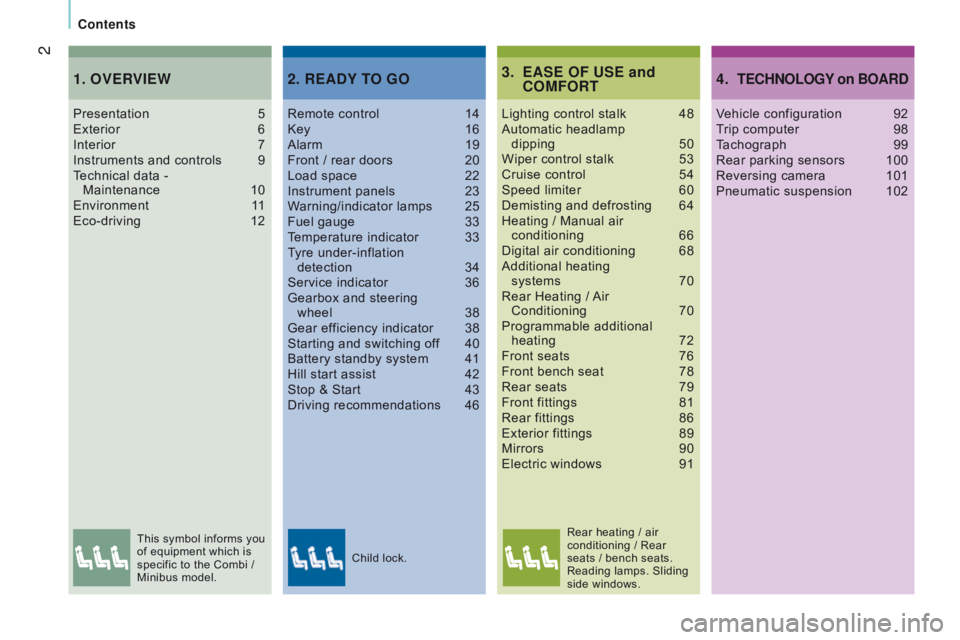
2
contents
3. EASE OF u SE and c
OMFO rt
Lighting control stalk 48
Automatic headlamp
dipping
50
Wiper control stalk
53
Cruise control
54
Speed limiter
60
Demisting and defrosting
64
Heating / Manual air
conditioning
66
Digital air conditioning
68
Additional heating
systems
70
Rear Heating /
Air
Conditioning
70
Programmable additional
heating
72
Front seats
76
Front bench seat
78
Rear seats
79
Front fittings
81
Rear fittings
86
Exterior fittings
89
Mirrors
90
Electric windows
91
Presentation
5
Exterior
6
Interior
7
Instruments and controls
9
T
echnical data -
Maintenance
10
Environment
1
1
Eco-driving
12
1. OVErVIEW 4. tEcHnOLOGY on BOArd
Vehicle configuration 92
T rip computer 98
T
achograph
99
Rear parking sensors
100
Reversing camera
101
Pneumatic suspension
102
2. rEAdY tO GO
Remote control 14
Key 16
Alarm
19
Front
/ rear doors
20
Load space
22
Instrument panels
23
W
arning/indicator lamps
25
Fuel gauge
33
T
emperature indicator
33
T
yre under-inflation
detection
34
Service indicator
36
Gearbox and steering
wheel
38
Gear ef
ficiency indicator
38
Starting and switching of
f
40
Battery standby system
41
Hill start assist
42
Stop & Start
43
Driving recommendations
46
This symbol informs you
of equipment which is
specific to the Combi /
Minibus model. Child lock.Rear heating / air
conditioning / Rear
seats / bench seats.
Reading lamps. Sliding
side windows.
Page 11 of 292
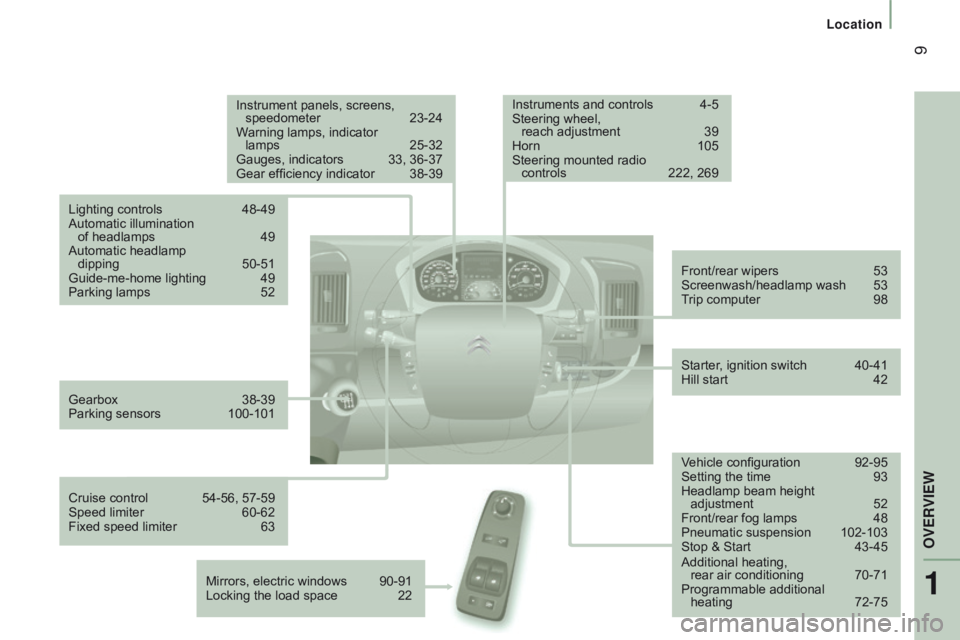
9
Gearbox 38-39
Parking sensors 100-101Instrument panels, screens,
speedometer
23-24
W
arning lamps, indicator
lamps
25-32
Gauges, indicators
33, 36-37
Gear efficiency indicator
38-39
Lighting controls
48-49
Automatic illumination
of headlamps
49
Automatic headlamp
dipping
50-51
Guide-me-home lighting
49
Parking lamps
52
V
ehicle configuration
92-95
Setting the time
93
Headlamp beam height
adjustment
52
Front/rear fog lamps
48
Pneumatic suspension
102-103
Stop & Start
43-45
Front/rear wipers
53
Screenwash/headlamp wash
53
T
rip computer
98
Starter
, ignition switch
40-41
Hill start
42
Cruise control
54-56, 57-59
Speed limiter
60-62
Fixed speed limiter
63 Instruments and controls
4-5
Steering wheel,
reach adjustment
39
Horn
105
Steering mounted radio
controls
222, 269
Mirrors, electric windows
90-91
Locking the load space
22 Additional heating,
rear air conditioning
70-71
Programmable additional
heating
72-75
1
OVERVIEW
Location
Page 12 of 292
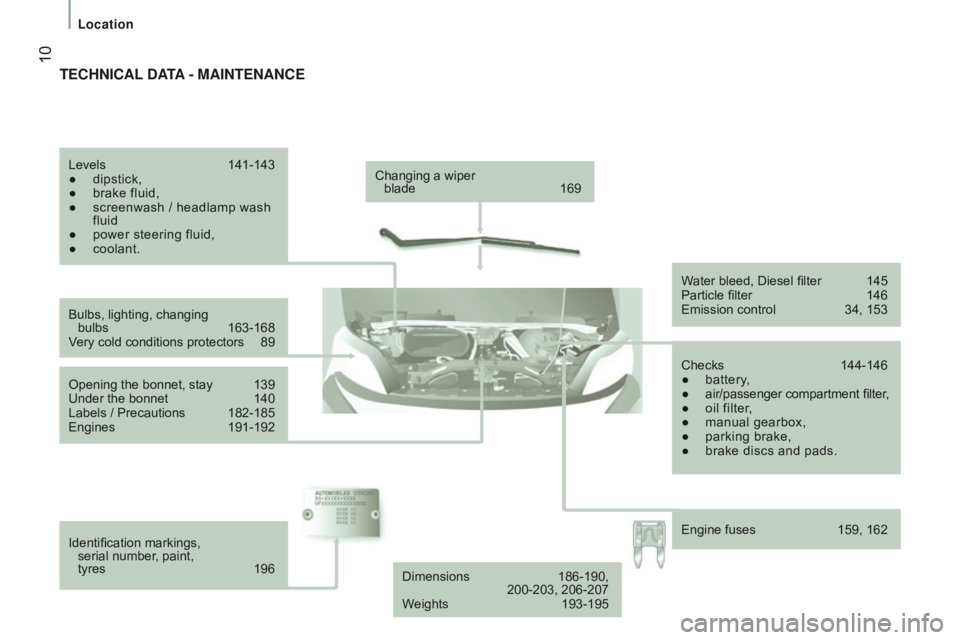
10
Changing a wiper
blade 169
Bulbs, lighting, changing
bulbs
163-168
V
ery cold conditions protectors
89
Opening the bonnet, stay
139
Under the bonnet
140
Labels / Precautions
182-185
Engines
191-192
Identification markings,
serial number
, paint,
tyres
196
Levels
141-143
●
dipstick,
●
brake fluid,
●
screenwash / headlamp wash
fluid
●
power steering fluid,
●
coolant. W
ater bleed, Diesel filter
145
Particle filter
146
Emission control
34, 153
Checks
144-146
●
battery
,
●
air/passenger compartment filter
,
●
oil filter
,
●
manual gearbox,
●
parking brake,
●
brake discs and pads.
tEcHnIcAL dAtA - M AI nt E n A nc E
Dimensions 186-190, 200-203, 206-207
W
eights
193-195 Engine fuses
159, 162
Location
Page 14 of 292

12
EcO-drIVInG
Optimise the use of your gearbox
With a manual gearbox, move off gently
and change up without waiting. While
accelerating changing up early. If your
vehicle has the system, the gear efficiency
indicator invites you to engage the most
suitable gear; follow its instructions as
soon as it is displayed in the instrument
panel.
drive smoothly
Maintain a safe distance between vehicles,
use engine braking rather than the
brake pedal, and press the accelerator
progressively. These practices contribute
towards a reduction in fuel consumption
and CO
2 emissions and also helps reduce
the background traffic noise.
If your vehicle has cruise control, make
use of the system at speeds above 20 mph
(30 km/h) when the traffic is flowing well.
control the use of your electrical
equipment
Before moving off, if the passenger
compartment is too warm, ventilate it by
opening the windows and air vents before
using the air conditioning.
Above 30 mph (50 km/h), close the
windows and leave the air vents open.
Remember to make use of equipment
that can help keep the temperature in the
passenger compartment down. Switch off the headlamps and front
foglamps when they are not needed for
safety.
Eco-driving is a range of everyday
practices that allow the motorist to optimise
their fuel consumption and CO
2 emissions.
Avoid running the engine before moving
off, particularly in winter; your vehicle will
warm up much faster while driving.
Disconnect your portable devices before
leaving the vehicle.Switch off the air conditioning, unless it
has automatic digital regulation, as soon
as the desired temperature is attained.
Switch off the demisting and defrosting
controls, if not automatic.
Switch off the heated seat as soon as
possible.
Motoring & the Environment
Page 34 of 292
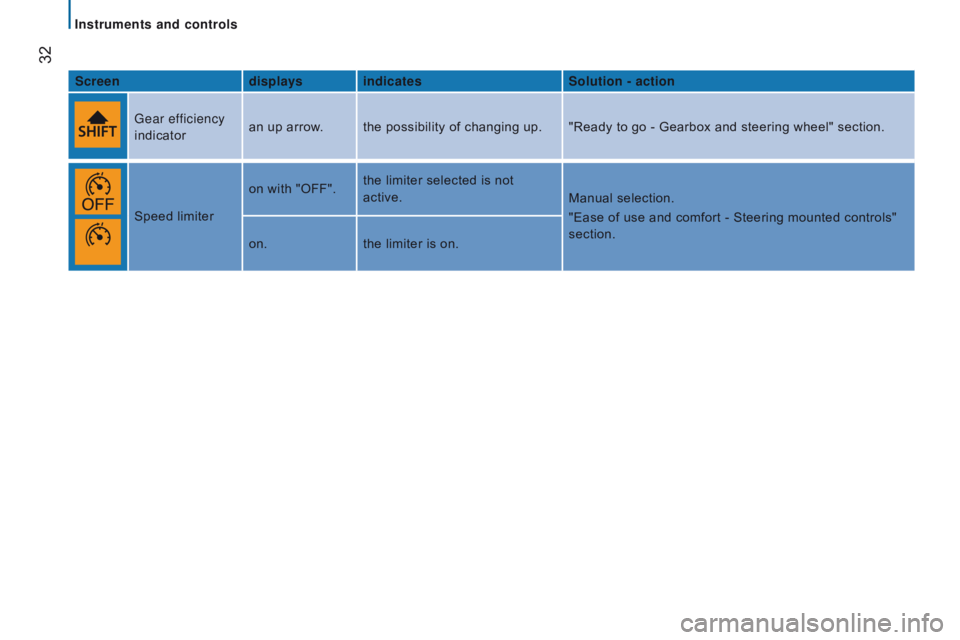
32
Screendisplays indicates Solution - action
Gear efficiency
indicator an up arrow. the possibility of changing up. "Ready to go - Gearbox and steering wheel" section.
Speed limiter on with "OFF".
the limiter selected is not
active.
Manual selection.
"Ease of use and comfort - Steering mounted controls"
section.
on. the limiter is on.
Instruments and controls
Page 40 of 292
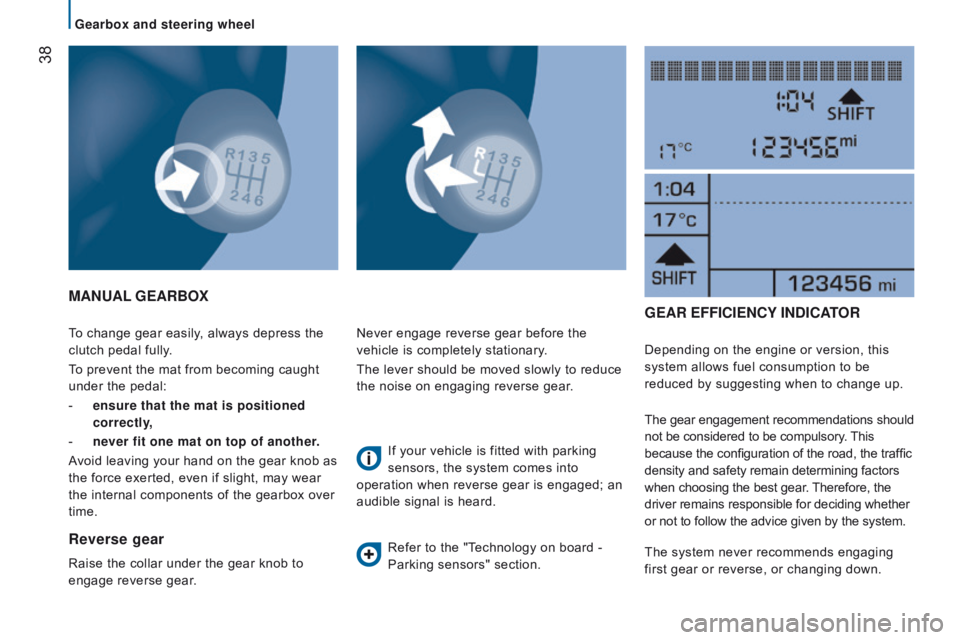
38
To change gear easily, always depress the
clutch pedal fully.
To prevent the mat from becoming caught
under the pedal:
-
ensure that the mat is positioned
correctly,
-
never fit one mat on top of another
.
Avoid leaving your hand on the gear knob as
the force exerted, even if slight, may wear
the internal components of the gearbox over
time.
MAnuAL GEA r BO x
r
everse gear
Raise the collar under the gear knob to
engage reverse gear. Never engage reverse gear before the
vehicle is completely stationary.
The lever should be moved slowly to reduce
the noise on engaging reverse gear.
If your vehicle is fitted with parking
sensors, the system comes into
operation when reverse gear is engaged; an
audible signal is heard.
Refer to the "Technology on board -
Parking sensors" section.
GEAr EFFIcIEncY IndIcAtO r
Depending on the engine or version, this
system allows fuel consumption to be
reduced by suggesting when to change up.
The gear engagement recommendations should
not be considered to be compulsory. This
because the configuration of the road, the traffic
density and safety remain determining factors
when choosing the best gear. Therefore, the
driver remains responsible for deciding whether
or not to follow the advice given by the system.
The system never recommends engaging
first gear or reverse, or changing down.
Gearbox and steering wheel
Page 41 of 292
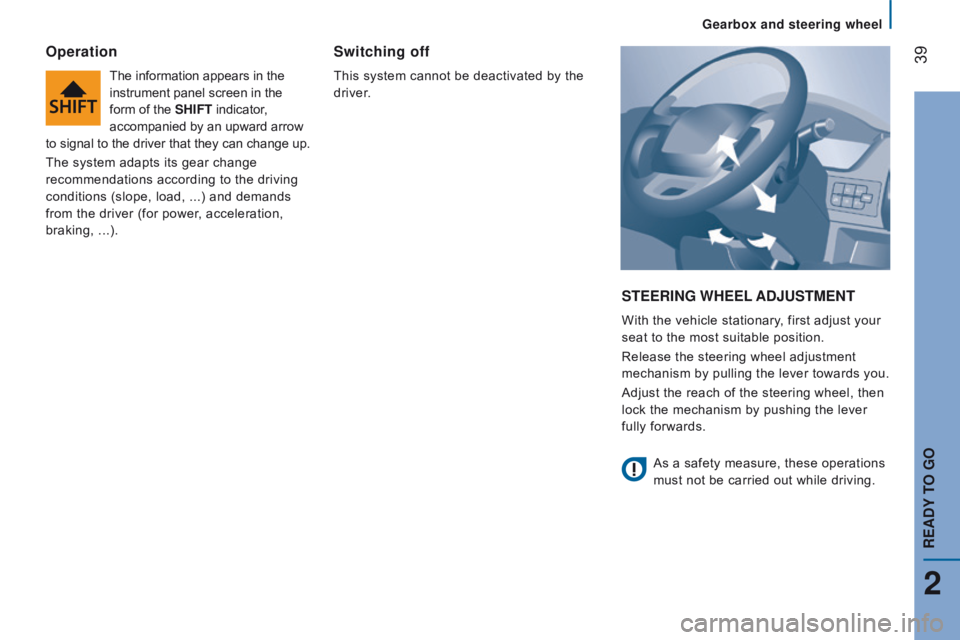
39
Gearbox and steering wheel
StEErInG WHEEL A dju S t ME nt
With the vehicle stationary, first adjust your
seat to the most suitable position.
Release the steering wheel adjustment
mechanism by pulling the lever towards you.
Adjust the reach of the steering wheel, then
lock the mechanism by pushing the lever
fully forwards.
Operation
The information appears in the
instrument panel screen in the
form of the SHIF
t indicator,
accompanied by an upward arrow
to signal to the driver that they can change up.
The system adapts its gear change
recommendations according to the driving
conditions (slope, load, ...) and demands
from the driver (for power, acceleration,
braking,
...).
Switching off
This system cannot be deactivated by the
driver.
As a safety measure, these operations
must not be carried out while driving.
2
rEAdY tO GO
Page 42 of 292
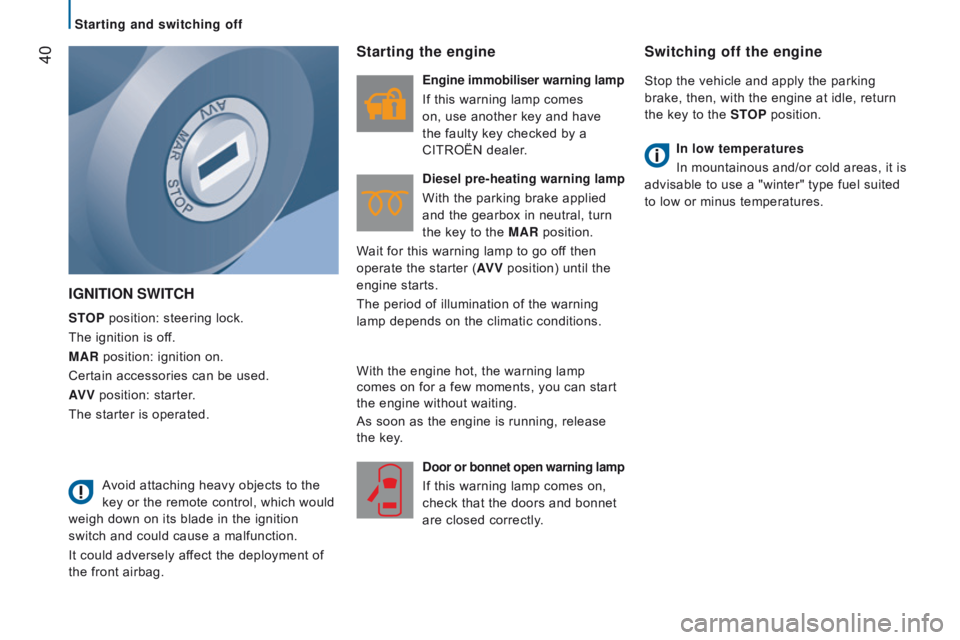
40
IGnItIOn SWItcH
StOP position: steering lock.
The ignition is off.
MA
r position: ignition on.
Certain accessories can be used.
AV V position: starter.
The starter is operated.
Starting the engine
Engine immobiliser warning lamp
If this warning lamp comes
on, use another key and have
the faulty key checked by a
CITROËN dealer.
d
iesel pre-heating warning lamp
With the parking brake applied
and the gearbox in neutral, turn
the key to the MA
r position.
Wait for this warning lamp to go off then
operate the starter (AV V position) until the
engine starts.
The period of illumination of the warning
lamp depends on the climatic conditions.
d
oor or bonnet open warning lamp
If this warning lamp comes on,
check that the doors and bonnet
are closed correctly.
Switching off the engine
Stop the vehicle and apply the parking
brake, then, with the engine at idle, return
the key to the S
t
OP
position.
In low temperatures
In mountainous and/or cold areas, it is
advisable to use a "winter" type fuel suited
to low or minus temperatures.
Avoid attaching heavy objects to the
key or the remote control, which would
weigh down on its blade in the ignition
switch and could cause a malfunction.
It could adversely affect the deployment of
the front airbag. With the engine hot, the warning lamp
comes on for a few moments, you can start
the engine without waiting.
As soon as the engine is running, release
the key.
Starting and switching off
Page 44 of 292
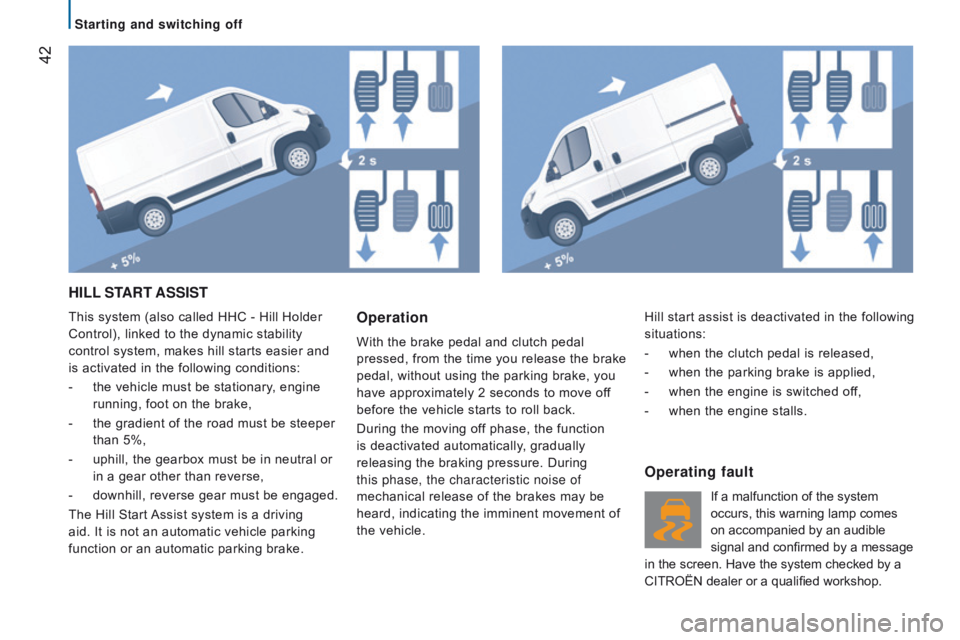
42
HILL StA rt ASSIS t
This system (also called HHC - Hill Holder
Control), linked to the dynamic stability
control system, makes hill starts easier and
is activated in the following conditions:
-
the vehicle must be stationary
, engine
running, foot on the brake,
-
the gradient of the road must be steeper
than 5%,
-
uphill, the gearbox must be in neutral or
in a gear other than reverse,
-
downhill, reverse gear must be engaged.
The Hill Start
Assist system is a driving
aid. It is not an automatic vehicle parking
function or an automatic parking brake.Operation
With the brake pedal and clutch pedal
pressed, from the time you release the brake
pedal, without using the parking brake, you
have approximately 2 seconds to move off
before the vehicle starts to roll back.
During the moving off phase, the function
is deactivated automatically, gradually
releasing the braking pressure. During
this phase, the characteristic noise of
mechanical release of the brakes may be
heard, indicating the imminent movement of
the vehicle.
Operating fault
If a malfunction of the system
occurs, this warning lamp comes
on accompanied by an audible
signal and confirmed by a message
in the screen. Have the system checked by a
CITROËN dealer or a qualified workshop. Hill start assist is deactivated in the following
situations:
-
when the clutch pedal is released,
-
when the parking brake is applied,
-
when the engine is switched of
f,
-
when the engine stalls.
Starting and switching off
Page 46 of 292
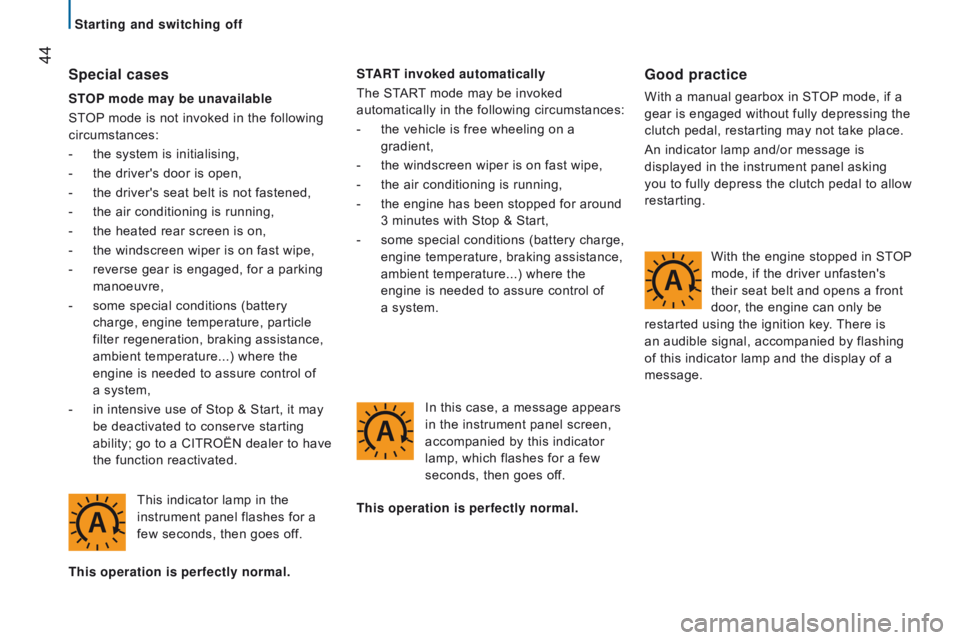
44Special cases
This indicator lamp in the
instrument panel flashes for a
few seconds, then goes off.
t
his operation is perfectly normal. S
t
A
rt invoked automatically
The START mode may be invoked
automatically in the following circumstances:
-
the vehicle is free wheeling on a
gradient,
-
the windscreen wiper is on fast wipe,
-
the air conditioning is running,
-
the engine has been stopped for around
3 minutes with Stop & Start,
-
some special conditions (battery charge,
engine temperature, braking assistance,
ambient temperature...) where the
engine is needed to assure control of
a system.
In this case, a message appears
in the instrument panel screen,
accompanied by this indicator
lamp, which flashes for a few
seconds, then goes off.
Good practice
With a manual gearbox in STOP mode, if a
gear is engaged without fully depressing the
clutch pedal, restarting may not take place.
An indicator lamp and/or message is
displayed in the instrument panel asking
you to fully depress the clutch pedal to allow
restarting.
t
his operation is perfectly normal. With the engine stopped in STOP
mode, if the driver unfasten's
their seat belt and opens a front
door, the engine can only be
restarted using the ignition key. There is
an audible signal, accompanied by flashing
of this indicator lamp and the display of a
message.
S
tOP
mode may be unavailable
STOP mode is not invoked in the following
circumstances:
-
the system is initialising,
-
the driver's door is open,
-
the driver's seat belt is not fastened,
-
the air conditioning is running,
-
the heated rear screen is on,
-
the windscreen wiper is on fast wipe,
-
reverse gear is engaged, for a parking
manoeuvre,
-
some special conditions (battery
charge, engine temperature, particle
filter regeneration, braking assistance,
ambient temperature...) where the
engine is needed to assure control of
a
system,
-
in intensive use of Stop & Start, it may
be deactivated to conserve starting
ability; go to a CITROËN dealer to have
the function reactivated.
Starting and switching off